Freescale Semiconductor
Data Sheet: Technical Data
Document Number S9KEA128P80M48SF0
Rev 4, 09/2014
KEA128 Sub-Family Data
Sheet
Supports the following:
S9KEAZ64AMLK(R),
S9KEAZ128AMLK(R),
S9KEAZ64AVLK(R),
S9KEAZ128AVLK(R),
S9KEAZ64ACLK(R),
S9KEAZ128ACLK(R),
S9KEAZ64AMLH(R),
S9KEAZ128AMLH(R),
S9KEAZ64AVLH(R),
S9KEAZ128AVLH(R),
S9KEAZ64ACLH(R) and
S9KEAZ128ACLH(R)
Key features
• Operating characteristics
– Voltage range: 2.7 to 5.5 V
– Flash write voltage range: 2.7 to 5.5 V
– Temperature range (ambient): -40 to 125°C
• Performance
– Up to 48 MHz ARM® Cortex-M0+ core
– Single cycle 32-bit x 32-bit multiplier
– Single cycle I/O access port
• Memories and memory interfaces
– Up to 128 KB flash
– Up to 16 KB RAM
• Clocks
– Oscillator (OSC) - supports 32.768 kHz crystal or 4
MHz to 24 MHz crystal or ceramic resonator; choice
of low power or high gain oscillators
– Internal clock source (ICS) - internal FLL with
internal or external reference, 37.5 kHz pre-trimmed
internal reference for 48 MHz system clock
– Internal 1 kHz low-power oscillator (LPO)
S9KEA128P80M48SF0
• System peripherals
– Power management module (PMC) with three power
modes: Run, Wait, Stop
– Low-voltage detection (LVD) with reset or interrupt,
selectable trip points
– Watchdog with independent clock source (WDOG)
– Programmable cyclic redundancy check module
(CRC)
– Serial wire debug interface (SWD)
– Aliased SRAM bitband region (BIT-BAND)
– Bit manipulation engine (BME)
• Security and integrity modules
– 80-bit unique identification (ID) number per chip
• Human-machine interface
– Up to 71 general-purpose input/output (GPIO)
– Two 32-bit keyboard interrupt modules (KBI)
– External interrupt (IRQ)
• Analog modules
– One up to 16-channel 12-bit SAR ADC, operation in
Stop mode, optional hardware trigger (ADC)
– Two analog comparators containing a 6-bit DAC
and programmable reference input (ACMP)
Freescale reserves the right to change the detail specifications as may be
required to permit improvements in the design of its products.
© 2014 Freescale Semiconductor, Inc.
�
• Timers
– One 6-channel FlexTimer/PWM (FTM)
– Two 2-channel FlexTimer/PWM (FTM)
– One 2-channel periodic interrupt timer (PIT)
– One pulse width timer (PWT)
– One real-time clock (RTC)
• Communication interfaces
– Two SPI modules (SPI)
– Up to three UART modules (UART)
– Two I2C modules (I2C)
– One MSCAN module (MSCAN)
• Package options
– 80-pin LQFP
– 64-pin LQFP
2
Freescale Semiconductor, Inc.
KEA128 Sub-Family Data Sheet, Rev4, 09/2014.
�
Table of Contents
1 Ordering parts.......................................................................................4
4.2.2
FTM module timing....................................................... 16
1.1 Determining valid orderable parts............................................... 4
4.3 Thermal specifications.................................................................17
2 Part identification................................................................................. 4
4.3.1
Thermal characteristics.................................................. 17
2.1 Description...................................................................................4
5 Peripheral operating requirements and behaviors................................ 19
2.2 Format..........................................................................................4
5.1 Core modules............................................................................... 19
2.3 Fields............................................................................................4
5.1.1
SWD electricals .............................................................19
2.4 Example....................................................................................... 5
5.2 External oscillator (OSC) and ICS characteristics.......................20
3 Ratings..................................................................................................5
5.3 NVM specifications..................................................................... 22
3.1 Thermal handling ratings............................................................. 5
5.4 Analog..........................................................................................23
3.2 Moisture handling ratings............................................................ 5
5.4.1 ADC characteristics....................................................... 23
3.3 ESD handling ratings................................................................... 6
5.4.2 Analog comparator (ACMP) electricals.........................25
3.4 Voltage and current operating ratings..........................................6
5.5 Communication interfaces........................................................... 26
4 General................................................................................................. 7
5.5.1
SPI switching specifications.......................................... 26
4.1 Nonswitching electrical specifications........................................ 7
5.5.2 MSCAN......................................................................... 29
4.1.1 DC characteristics.......................................................... 7
6 Dimensions...........................................................................................29
4.1.2
Supply current characteristics........................................ 13
6.1 Obtaining package dimensions.................................................... 29
4.1.3
EMC performance..........................................................15
7 Pinout................................................................................................... 30
4.2 Switching specifications.............................................................. 15
7.1 Signal multiplexing and pin assignments.................................... 30
4.2.1
Control timing................................................................ 15
8 Revision History...................................................................................30
Freescale Semiconductor, Inc.
3
KEA128 Sub-Family Data Sheet, Rev4, 09/2014.
�
Ordering parts
1
Ordering parts
1.1 Determining valid orderable parts
Valid orderable part numbers are provided on the web. To determine the orderable part
numbers for this device, go to freescale.com and perform a part number search for the
following device numbers: KEAZ128.
2
Part identification
2.1 Description
Part numbers for the chip have fields that identify the specific part. You can use the
values of these fields to determine the specific part you have received.
2.2 Format
Part numbers for this device have the following format:
Q B KEA A C FFF M T PP N
2.3 Fields
This table lists the possible values for each field in the part number (not all combinations
are valid):
Field
Q
B
KEA
A
C
Description
Qualification status
Memory type
Kinetis Auto family
Key attribute
CAN availability
Values
• S = Automotive qualified
• P = Prequalification
• 9 = Flash
• KEA
• Z = M0+ core
• F = M4 W/ DSP & FPU
• C= M4 W/ AP + FPU
• N = CAN not available
• (Blank) = CAN available
Table continues on the next page...
4
Freescale Semiconductor, Inc.
KEA128 Sub-Family Data Sheet, Rev4, 09/2014.
�
Field
FFF
M
T
PP
N
Description
Program flash memory size
Maskset revision
Temperature range (°C)
Package identifier
Packaging type
Ratings
Values
• 128 = 128 KB
• A = 1st Fab version
• B = Revision after 1st version
• C = –40 to 85
• V= –40 to 105
• M = –40 to 125
• LH = 64 LQFP (10 mm x 10 mm)
• LK = 80 LQFP (14 mm x 14 mm)
• R = Tape and reel
• (Blank) = Trays
2.4 Example
This is an example part number:
S9KEAZ128AMLK
3
Ratings
3.1 Thermal handling ratings
Symbol
TSTG
TSDR
Description
Storage temperature
Solder temperature, lead-free
Min.
–55
—
Max.
150
260
Unit
°C
°C
Notes
1
2
1. Determined according to JEDEC Standard JESD22-A103, High Temperature Storage Life.
2. Determined according to IPC/JEDEC Standard J-STD-020, Moisture/Reflow Sensitivity Classification for Nonhermetic
Solid State Surface Mount Devices.
3.2 Moisture handling ratings
Symbol
Description
MSL
Moisture sensitivity level
Min.
—
Max.
3
Unit
—
Notes
1
1. Determined according to IPC/JEDEC Standard J-STD-020, Moisture/Reflow Sensitivity Classification for Nonhermetic
Solid State Surface Mount Devices.
Freescale Semiconductor, Inc.
5
KEA128 Sub-Family Data Sheet, Rev4, 09/2014.
�
Ratings
3.3 ESD handling ratings
Symbol
VHBM
VCDM
ILAT
Description
Electrostatic discharge voltage, human body model
Electrostatic discharge voltage, charged-device model
Latch-up current at ambient temperature of °C
Min.
–6000
–500
–100
Max.
+6000
+500
+100
Unit
V
V
mA
Notes
1
2
3
1. Determined according to JEDEC Standard JESD22-A114, Electrostatic Discharge (ESD) Sensitivity Testing Human Body
Model (HBM).
2. Determined according to JEDEC Standard JESD22-C101, Field-Induced Charged-Device Model Test Method for
Electrostatic-Discharge-Withstand Thresholds of Microelectronic Components.
3. Determined according to JEDEC Standard JESD78D, IC Latch-up Test. The test produced the following results:
• Test was performed at 125 °C case temperature (Class II).
• I/O pins pass +100/-100 mA I-test with IDD current limit at 400 mA (VDD collapsed during positive injection).
• I/O pins pass +50/-100 mA I-test with IDD current limit at 1000 mA for VDD.
• Supply groups pass 1.5 Vccmax.
• RESET_B pin was only tested with negative I-test due to product conditioning requirement.
3.4 Voltage and current operating ratings
Absolute maximum ratings are stress ratings only, and functional operation at the
maxima is not guaranteed. Stress beyond the limits specified in the following table may
affect device reliability or cause permanent damage to the device. For functional
operating conditions, refer to the remaining tables in this document.
This device contains circuitry protecting against damage due to high static voltage or
electrical fields; however, it is advised that normal precautions be taken to avoid
application of any voltages higher than maximum-rated voltages to this high-impedance
circuit. Reliability of operation is enhanced if unused inputs are tied to an appropriate
logic voltage level (for instance, either VSS or VDD) or the programmable pullup resistor
associated with the pin is enabled.
Table 1. Voltage and current operating ratings
Symbol
Description
VDD
IDD
VIN
ID
VDDA
Digital supply voltage
Maximum current into VDD
Input voltage except true open drain pins
Input voltage of true open drain pins
Instantaneous maximum current single pin limit (applies to all
port pins)
Analog supply voltage
Min.
–0.3
—
–0.3
–0.3
–25
Max.
6.0
120
VDD + 0.31
6
25
VDD – 0.3
VDD + 0.3
Unit
V
mA
V
V
mA
V
1. Maximum rating of VDD also applies to VIN.
6
Freescale Semiconductor, Inc.
KEA128 Sub-Family Data Sheet, Rev4, 09/2014.
�
General
4
General
4.1
Nonswitching electrical specifications
4.1.1 DC characteristics
This section includes information about power supply requirements and I/O pin
characteristics.
Table 2. DC characteristics
Symbol
—
VOH
Descriptions
Operating voltage
—
Output
high
voltage
All I/O pins, except PTA2
and PTA3, standard-drive
strength
5 V, Iload = –5 mA
3 V, Iload = –2.5 mA
High current drive pins,
high-drive strength2
5 V, Iload = –20 mA
3 V, Iload = –10 mA
Min
2.7
VDD – 0.8
VDD – 0.8
VDD – 0.8
VDD – 0.8
Max total IOH for all ports
All I/O pins, standard-drive
strength
High current drive pins,
high-drive strength2
Max total IOL for all ports
All digital inputs
All digital inputs
5 V
3 V
5 V, Iload = 5 mA
3 V, Iload = 2.5 mA
5 V, Iload =20 mA
3 V, Iload = 10 mA
5 V
3 V
4.5≤VDD<5.5 V
2.7≤VDD<4.5 V
4.5≤VDD<5.5 V
2.7≤VDD<4.5 V
—
—
—
—
—
—
—
—
0.65 × VDD
0.70 × VDD
—
—
All digital inputs
—
0.06 × VDD
IOHT
VOL
IOLT
VIH
VIL
Vhys
|IIn|
Output
high
current
Output
low
voltage
Output
low
current
Input high
voltage
Input low
voltage
Input
hysteresis
Input
leakage
current
Typical1
Max
Unit
—
—
—
—
—
—
—
—
—
—
—
—
—
—
—
—
—
—
5.5
—
—
—
—
–100
–60
0.8
0.8
0.8
0.8
100
60
—
—
0.35 ×
VDD
0.30 ×
VDD
—
V
V
V
V
V
mA
V
V
V
V
mA
V
V
mV
µA
Per pin (pins in high
impedance input mode)
VIN = VDD or VSS
—
0.1
1
Table continues on the next page...
Freescale Semiconductor, Inc.
7
KEA128 Sub-Family Data Sheet, Rev4, 09/2014.
�
Nonswitching electrical specifications
Table 2. DC characteristics (continued)
Symbol
|IINTOT|
Total
leakage
combined
for all port
pins
Descriptions
Pins in high impedance
input mode
VIN = VDD or VSS
RPU
3
RPU
IIC
CIn
VRAM
Pullup
resistors
All digital inputs, when
enabled (all I/O pins other
than PTA2 and PTA3)
PTA2 and PTA3 pins
—
—
Pullup
resistors
DC
injection
current4,
5, 6
Single pin limit
VIN < VSS, VIN > VDD
Total MCU limit, includes
sum of all stressed pins
Input capacitance, all pins
RAM retention voltage
—
—
Min
—
30.0
30.0
-2
-5
—
2.0
Typical1
—
—
—
—
—
—
—
Max
2
Unit
µA
50.0
kΩ
60.0
2
25
7
—
kΩ
mA
pF
V
1. Typical values are measured at 25 °C. Characterized, not tested.
2. Only PTB4, PTB5, PTD0, PTD1, PTE0, PTE1, PTH0, and PTH1 support high current output.
3. The specified resistor value is the actual value internal to the device. The pullup value may appear higher when measured
externally on the pin.
4. All functional non-supply pins, except for PTA2 and PTA3, are internally clamped to VSS and VDD. PTA2 and PTA3 are true
5.
open drain I/O pins that are internally clamped to VSS.
Input must be current limited to the value specified. To determine the value of the required current-limiting resistor,
calculate resistance values for positive and negative clamp voltages, then use the larger value.
6. Power supply must maintain regulation within operating VDD range during instantaneous and operating maximum current
conditions. If the positive injection current (VIn > VDD) is higher than IDD, the injection current may flow out of VDD and could
result in external power supply going out of regulation. Ensure that external VDD load will shunt current higher than
maximum injection current when the MCU is not consuming power, such as when no system clock is present, or clock rate
is very low (which would reduce overall power consumption).
Table 3. LVD and POR specification
Symbol
VPOR
VLVDH
VLVW1H
VLVW2H
VLVW3H
VLVW4H
VHYSH
Description
POR re-arm voltage1
Falling low-voltage detect
threshold—high range (LVDV =
1)2
range
voltage warning
threshold— high
Falling low-
Level 1 falling
(LVWV = 00)
Level 2 falling
(LVWV = 01)
Level 3 falling
(LVWV = 10)
Level 4 falling
(LVWV = 11)
High range low-voltage detect/
Min
1.5
4.2
4.3
4.5
4.6
4.7
—
Typ
1.75
4.3
4.4
4.5
4.6
4.7
100
Max
2.0
4.4
4.5
4.6
4.7
4.8
—
Unit
V
V
V
V
V
V
mV
warning hysteresis
Table continues on the next page...
8
Freescale Semiconductor, Inc.
KEA128 Sub-Family Data Sheet, Rev4, 09/2014.
�
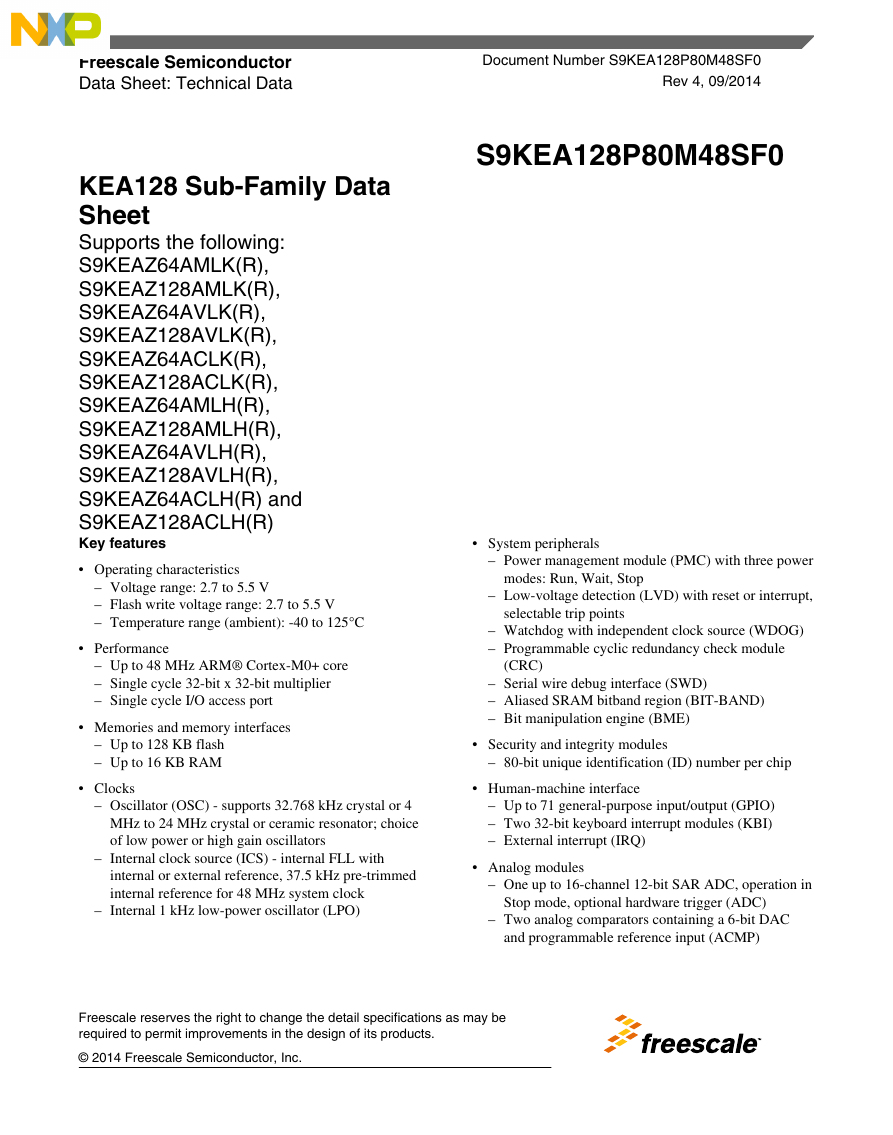


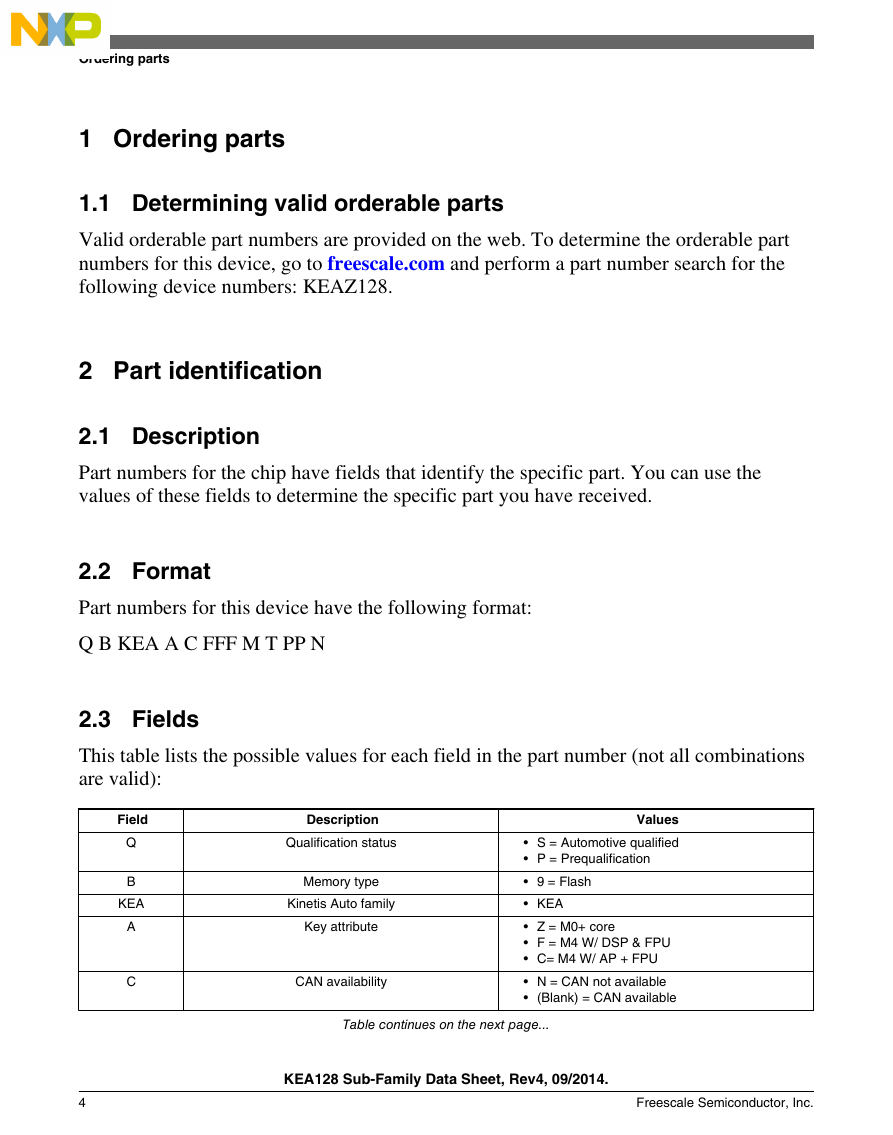
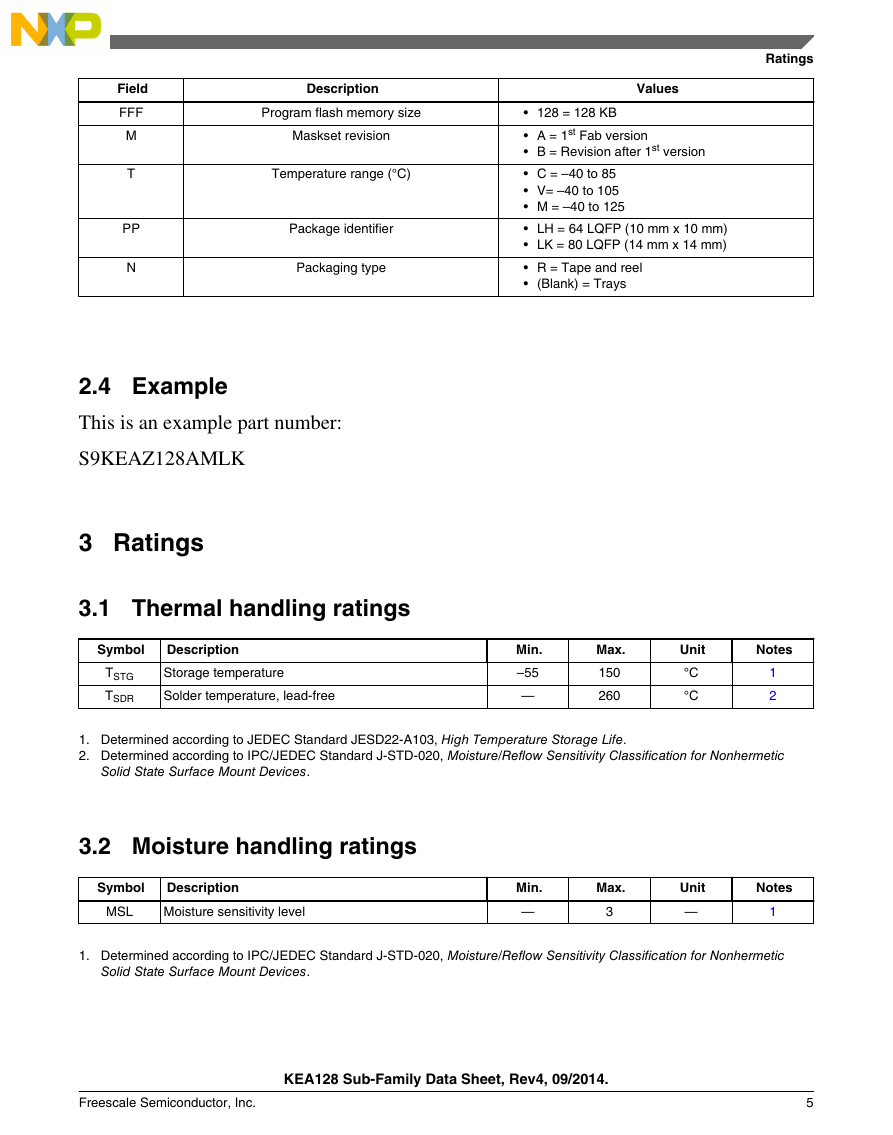
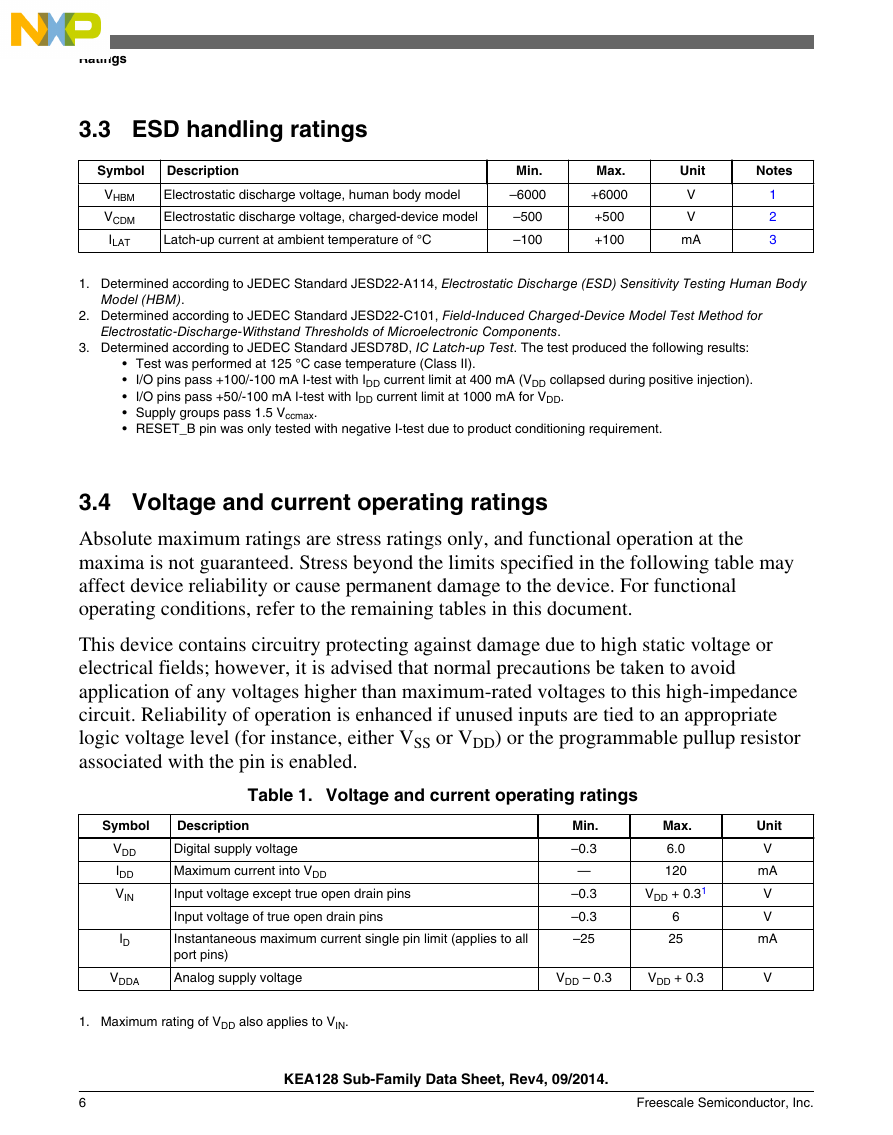
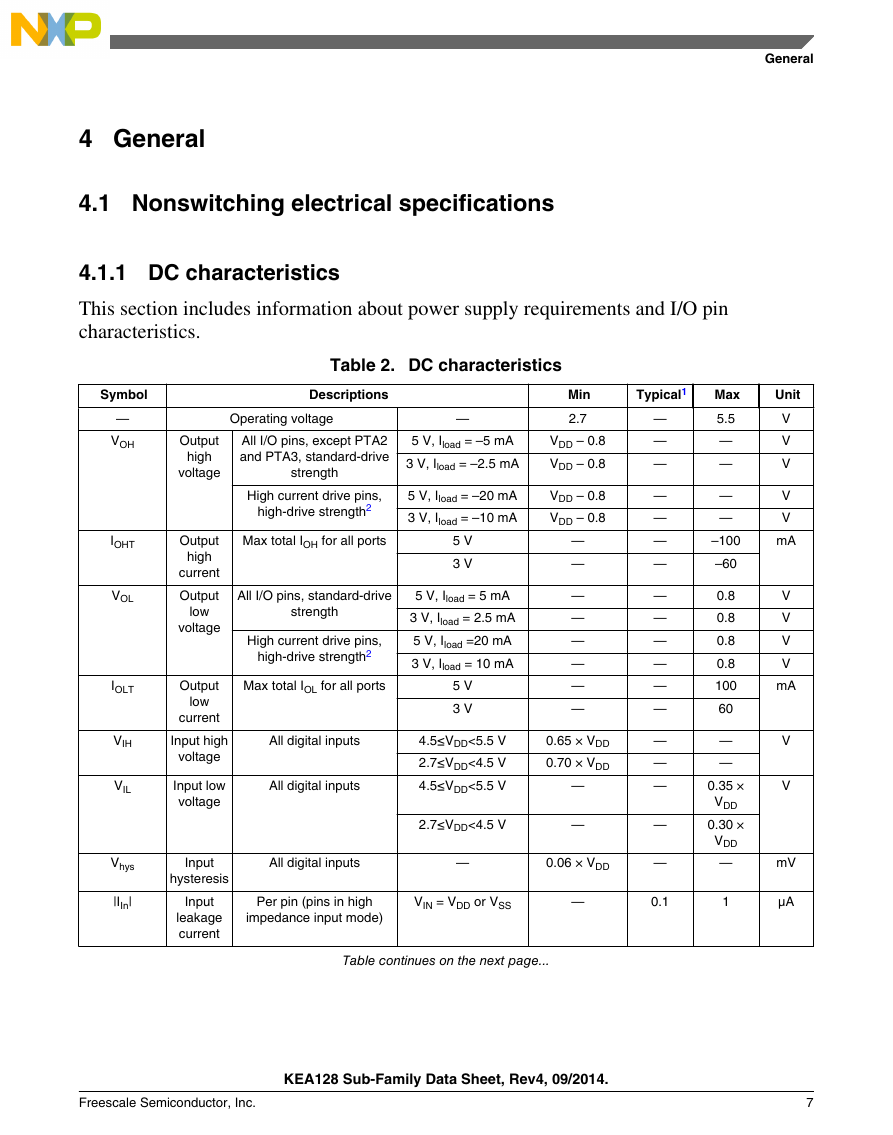
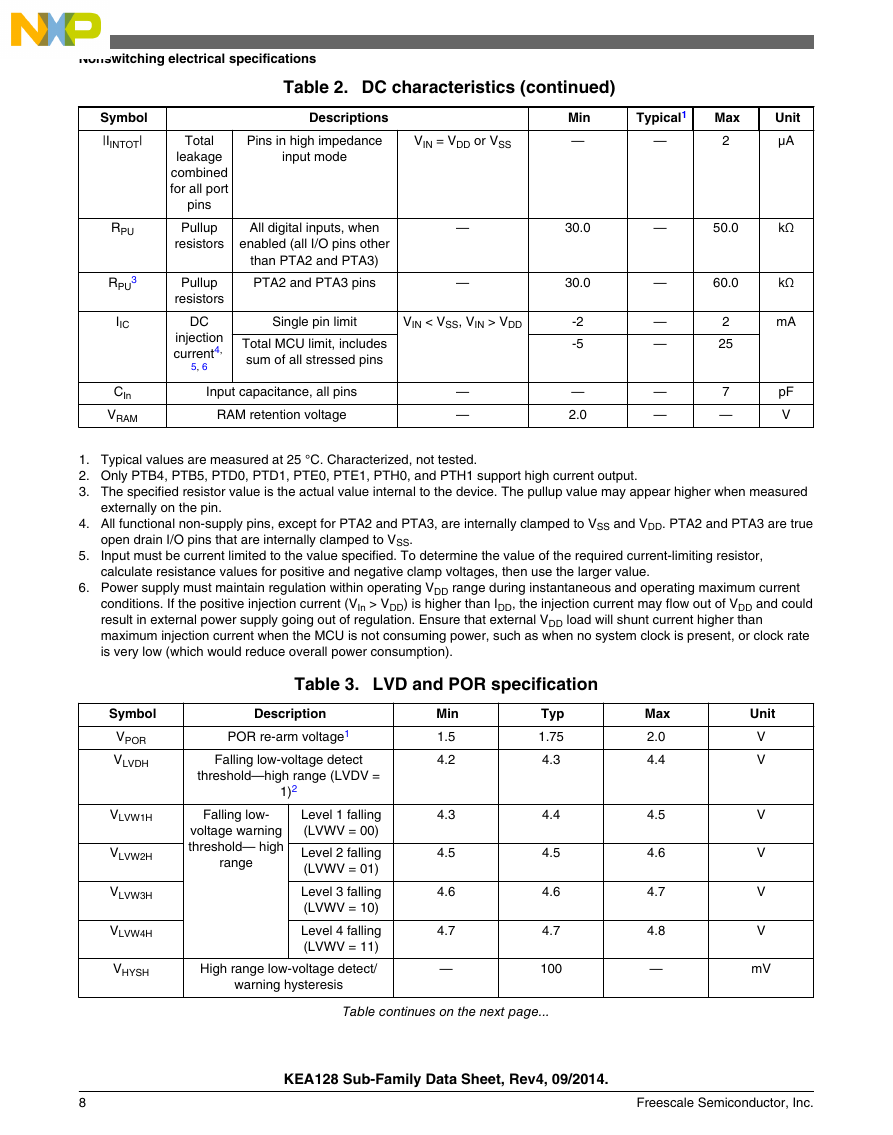








 2023年江西萍乡中考道德与法治真题及答案.doc
2023年江西萍乡中考道德与法治真题及答案.doc 2012年重庆南川中考生物真题及答案.doc
2012年重庆南川中考生物真题及答案.doc 2013年江西师范大学地理学综合及文艺理论基础考研真题.doc
2013年江西师范大学地理学综合及文艺理论基础考研真题.doc 2020年四川甘孜小升初语文真题及答案I卷.doc
2020年四川甘孜小升初语文真题及答案I卷.doc 2020年注册岩土工程师专业基础考试真题及答案.doc
2020年注册岩土工程师专业基础考试真题及答案.doc 2023-2024学年福建省厦门市九年级上学期数学月考试题及答案.doc
2023-2024学年福建省厦门市九年级上学期数学月考试题及答案.doc 2021-2022学年辽宁省沈阳市大东区九年级上学期语文期末试题及答案.doc
2021-2022学年辽宁省沈阳市大东区九年级上学期语文期末试题及答案.doc 2022-2023学年北京东城区初三第一学期物理期末试卷及答案.doc
2022-2023学年北京东城区初三第一学期物理期末试卷及答案.doc 2018上半年江西教师资格初中地理学科知识与教学能力真题及答案.doc
2018上半年江西教师资格初中地理学科知识与教学能力真题及答案.doc 2012年河北国家公务员申论考试真题及答案-省级.doc
2012年河北国家公务员申论考试真题及答案-省级.doc 2020-2021学年江苏省扬州市江都区邵樊片九年级上学期数学第一次质量检测试题及答案.doc
2020-2021学年江苏省扬州市江都区邵樊片九年级上学期数学第一次质量检测试题及答案.doc 2022下半年黑龙江教师资格证中学综合素质真题及答案.doc
2022下半年黑龙江教师资格证中学综合素质真题及答案.doc